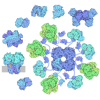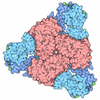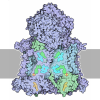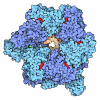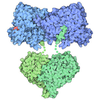+ Open data
Open data
- Basic information
Basic information
| Entry | Database: PDB / ID: 9uhb | |||||||||
|---|---|---|---|---|---|---|---|---|---|---|
| Title | BCCP-CT Conformation of AMPPNP-bound hPCC | |||||||||
 Components Components |
| |||||||||
 Keywords Keywords | TRANSFERASE / carboxylase | |||||||||
| Function / homology |  Function and homology information Function and homology informationshort-chain fatty acid catabolic process / branched-chain amino acid metabolic process / Propionyl-CoA catabolism / propionyl-CoA carboxylase / propionyl-CoA carboxylase activity / Defective HLCS causes multiple carboxylase deficiency / Biotin transport and metabolism / biotin binding / catalytic complex / Mitochondrial protein degradation ...short-chain fatty acid catabolic process / branched-chain amino acid metabolic process / Propionyl-CoA catabolism / propionyl-CoA carboxylase / propionyl-CoA carboxylase activity / Defective HLCS causes multiple carboxylase deficiency / Biotin transport and metabolism / biotin binding / catalytic complex / Mitochondrial protein degradation / fatty acid metabolic process / mitochondrial matrix / enzyme binding / mitochondrion / ATP binding / metal ion binding / cytosol Similarity search - Function | |||||||||
| Biological species |  Homo sapiens (human) Homo sapiens (human) | |||||||||
| Method | ELECTRON MICROSCOPY / single particle reconstruction / cryo EM / Resolution: 3.16 Å | |||||||||
 Authors Authors | Ni, F.Y. / Yan, H.F. / Wang, Q.H. / Ma, J.P. | |||||||||
| Funding support |  China, 2items China, 2items
| |||||||||
 Citation Citation |  Journal: Structure / Year: 2025 Journal: Structure / Year: 2025Title: Nanoscale conformational dynamics of human propionyl-CoA carboxylase. Authors: Huifang Yan / Fengyun Ni / Qinghua Wang / Jianpeng Ma /  Abstract: Propionyl-CoA carboxylase (PCC) is a biotin-dependent mitochondrial enzyme responsible for propionyl-CoA catabolism. Deficiencies in human PCC (hPCC) cause propionic acidemia, a severe metabolic ...Propionyl-CoA carboxylase (PCC) is a biotin-dependent mitochondrial enzyme responsible for propionyl-CoA catabolism. Deficiencies in human PCC (hPCC) cause propionic acidemia, a severe metabolic disorder driven by toxic metabolite accumulation. Despite its therapeutic relevance, the structural basis of hPCC's catalytic function remains unresolved. Here, we present high-resolution cryo-EM structures of hPCC in four distinct states, unliganded, ADP-, AMPPNP-, and ATP-bound/substrate-bound, capturing the full trajectory of the biotin carboxyl carrier protein (BCCP) domain as it translocates between active sites. Our results reinforce the crucial role of nucleotide-gated B-lid subdomain in synchronizing catalysis through coupling with BCCP movement. Structural and biochemical analysis of 10 disease-associated variants reveals how mutations disrupt key domain interfaces and dynamic motions required for activity. These new insights define the mechanistic principles governing hPCC functions, establish a structural framework for understanding PCC-related disorders, and lay the groundwork for future efforts to engineer functional replacements or modulators for metabolic therapy. | |||||||||
| History |
|
- Structure visualization
Structure visualization
| Structure viewer | Molecule:  Molmil Molmil Jmol/JSmol Jmol/JSmol |
|---|
- Downloads & links
Downloads & links
- Download
Download
| PDBx/mmCIF format |  9uhb.cif.gz 9uhb.cif.gz | 219.6 KB | Display |  PDBx/mmCIF format PDBx/mmCIF format |
|---|---|---|---|---|
| PDB format |  pdb9uhb.ent.gz pdb9uhb.ent.gz | 170.3 KB | Display |  PDB format PDB format |
| PDBx/mmJSON format |  9uhb.json.gz 9uhb.json.gz | Tree view |  PDBx/mmJSON format PDBx/mmJSON format | |
| Others |  Other downloads Other downloads |
-Validation report
| Summary document |  9uhb_validation.pdf.gz 9uhb_validation.pdf.gz | 1.7 MB | Display |  wwPDB validaton report wwPDB validaton report |
|---|---|---|---|---|
| Full document |  9uhb_full_validation.pdf.gz 9uhb_full_validation.pdf.gz | 1.7 MB | Display | |
| Data in XML |  9uhb_validation.xml.gz 9uhb_validation.xml.gz | 52.8 KB | Display | |
| Data in CIF |  9uhb_validation.cif.gz 9uhb_validation.cif.gz | 77.6 KB | Display | |
| Arichive directory |  https://data.pdbj.org/pub/pdb/validation_reports/uh/9uhb https://data.pdbj.org/pub/pdb/validation_reports/uh/9uhb ftp://data.pdbj.org/pub/pdb/validation_reports/uh/9uhb ftp://data.pdbj.org/pub/pdb/validation_reports/uh/9uhb | HTTPS FTP |
-Related structure data
| Related structure data |  64161MC  8zuxC  8zuyC  8zuzC  8zv0C  8zv1C  8zv2C  8zv3C  8zv4C  8zv5C  8zv6C  9uh1C  9uh2C  9uh5C  9uh6C  9uh8C  9uhrC  9uhsC  9uhyC M: map data used to model this data C: citing same article ( |
|---|---|
| Similar structure data | Similarity search - Function & homology  F&H Search F&H Search |
- Links
Links
- Assembly
Assembly
| Deposited unit | 
|
|---|---|
| 1 |
|
- Components
Components
-Protein , 1 types, 1 molecules A
| #1: Protein | Mass: 80161.922 Da / Num. of mol.: 1 Source method: isolated from a genetically manipulated source Source: (gene. exp.)  Homo sapiens (human) / Gene: PCCA / Production host: Homo sapiens (human) / Gene: PCCA / Production host:  Homo sapiens (human) / References: UniProt: P05165, propionyl-CoA carboxylase Homo sapiens (human) / References: UniProt: P05165, propionyl-CoA carboxylase |
|---|
-Propionyl-CoA carboxylase beta chain, ... , 2 types, 2 molecules BF
| #2: Protein | Mass: 27095.178 Da / Num. of mol.: 1 Source method: isolated from a genetically manipulated source Source: (gene. exp.)  Homo sapiens (human) / Gene: PCCB / Production host: Homo sapiens (human) / Gene: PCCB / Production host:  Homo sapiens (human) / References: UniProt: P05166, propionyl-CoA carboxylase Homo sapiens (human) / References: UniProt: P05166, propionyl-CoA carboxylase |
|---|---|
| #3: Protein | Mass: 31207.490 Da / Num. of mol.: 1 Source method: isolated from a genetically manipulated source Source: (gene. exp.)  Homo sapiens (human) / Gene: PCCB / Production host: Homo sapiens (human) / Gene: PCCB / Production host:  Homo sapiens (human) / References: UniProt: P05166, propionyl-CoA carboxylase Homo sapiens (human) / References: UniProt: P05166, propionyl-CoA carboxylase |
-Non-polymers , 4 types, 4 molecules 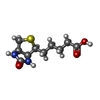






| #4: Chemical | ChemComp-BTN / |
|---|---|
| #5: Chemical | ChemComp-ANP / |
| #6: Chemical | ChemComp-MG / |
| #7: Chemical | ChemComp-1VU / |
-Details
| Has ligand of interest | Y |
|---|---|
| Has protein modification | Y |
-Experimental details
-Experiment
| Experiment | Method: ELECTRON MICROSCOPY |
|---|---|
| EM experiment | Aggregation state: PARTICLE / 3D reconstruction method: single particle reconstruction |
- Sample preparation
Sample preparation
| Component | Name: Propionyl-CoA carboxylase / Type: COMPLEX / Entity ID: #1-#3 / Source: RECOMBINANT |
|---|---|
| Source (natural) | Organism:  Homo sapiens (human) Homo sapiens (human) |
| Source (recombinant) | Organism:  Homo sapiens (human) Homo sapiens (human) |
| Buffer solution | pH: 8 |
| Specimen | Embedding applied: NO / Shadowing applied: NO / Staining applied: NO / Vitrification applied: YES |
| Vitrification | Cryogen name: ETHANE |
- Electron microscopy imaging
Electron microscopy imaging
| Experimental equipment |  Model: Titan Krios / Image courtesy: FEI Company |
|---|---|
| Microscopy | Model: TFS KRIOS |
| Electron gun | Electron source:  FIELD EMISSION GUN / Accelerating voltage: 300 kV / Illumination mode: SPOT SCAN FIELD EMISSION GUN / Accelerating voltage: 300 kV / Illumination mode: SPOT SCAN |
| Electron lens | Mode: BRIGHT FIELD / Nominal defocus max: 2000 nm / Nominal defocus min: 600 nm |
| Image recording | Electron dose: 50 e/Å2 / Film or detector model: GATAN K3 BIOQUANTUM (6k x 4k) |
- Processing
Processing
| EM software | Name: PHENIX / Version: 1.19.2_4158 / Category: model refinement | ||||||||||||||||||||||||
|---|---|---|---|---|---|---|---|---|---|---|---|---|---|---|---|---|---|---|---|---|---|---|---|---|---|
| CTF correction | Type: NONE | ||||||||||||||||||||||||
| 3D reconstruction | Resolution: 3.16 Å / Resolution method: FSC 0.143 CUT-OFF / Num. of particles: 101175 / Symmetry type: POINT | ||||||||||||||||||||||||
| Refinement | Highest resolution: 3.16 Å Stereochemistry target values: REAL-SPACE (WEIGHTED MAP SUM AT ATOM CENTERS) | ||||||||||||||||||||||||
| Refine LS restraints |
|
 Movie
Movie Controller
Controller





















 PDBj
PDBj
